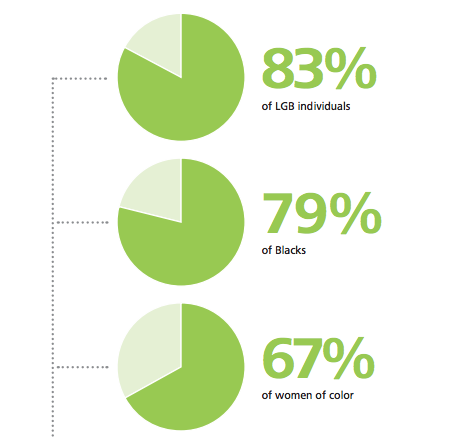Strategies for building an inclusive workplace

An inclusive workplace makes a difference for more than half of all employees who currently hide aspects of their identity at work. These include the working mom who has been penalized for family responsibilities. And the immigrant worker who erased their native accent to be less of a ‘foreigner.’ And the LGBT worker who doesn’t feel safe enough to be out.

Who’s covering their identity at work? Image via Deloitte.
It’s a worthwhile goal for any employer to create an environment where employees of every demographic feel welcomed, supported and able to succeed. We’ll categorize those efforts under the term ‘inclusion.’ Inclusion puts diversity to work, encouraging respect for individual perspectives and cultures in the workplace.
An inclusive workplace also helps companies understand the needs of a diverse customer base. Ipsita Agarwhal, a startup founder, engineer and journalist, wrote about the misalignment between Internet.org and the everyday needs of millions of Indian citizens who don’t have access to the internet. She affirms that:
“The single most obvious reason to push hard for diversity is that promoting diversity means promoting understanding. And that leads to better products that solve problems for those who might’ve otherwise been sidelined.”
Meanwhile, the creative agency Anomaly New York has a track record of crafting campaigns that resonate with a diverse audience, such as their campaign for YouTube Music and YouTube’s #ProudToLove spot. “Our agency is flat and flexible—our teams are built on a diversity of talent,” says Kara Wilsher, a partner at Anomaly. They have a markedly inclusive culture, which includes a healthy attitude towards debate and conflict as well as including employees in every part of the creative process.
For companies that are just starting out, Patreon CEO Jack Conte rounded up a great list of replicable and effective tasks for kickstarting a diversity and inclusion program. For workplaces that are ready to scale up, here are a few big ideas for shaping an inclusive work culture and what inclusion looks like at some of the best companies around.
Contents
Inclusive company policies
Dawn Bovasso, VP and Group Creative Director at DigitasLBi reports that in most places she’s worked, expense policies disadvantage parents—especially mothers. Companies will often reimburse travel expenses, but won’t cover costs for employees to maintain their homes (e.g. babysitting) when they’re away. As a result, a company dinner that was a treat for her colleagues seemed like less of a treat for her:
“I’m a single mom living in downtown Boston, which meant that I’d have to arrange for a sitter from about 6 p.m.-midnight at $20/hour. Add in some Tasty Burger for my son and the sitter, her tip and Uber home, and this appreciation dinner was going to end up costing me about $200.”
What do family-friendly policies look like? For the sake of comparison, Zendesk offers ‘returnships’ for mothers returning to the workforce. And Patagonia covers the cost for on-site childcare for their employees. Policies (any of them: recruitment, promotions, paid time off) can always be rewritten so that some groups of employees are not left in the lurch. They’re a powerful and public way to stand up for employees’ rights and shape a more inclusive workplace.
Employee resource groups
“There’s increased enthusiasm for [Employee Resource Groups] on the national level,” says Nilda Mahrer, manager of human resources programs and diversity at AtlantiCare, a leading healthcare provider in New Jersey. “Organizations have realized the business value and impact on organizational outcomes—such as high employee engagement levels and customer experiences.”
Employee resource groups (ERGs) are internal communities led by employees and for employees. These networks are a win-win for employees and organizations. For employees, especially those from underrepresented groups, ERGs are a way to connect with peers and mentors who have had similar experiences.
For employers, ERGs are an effective long-term diversity and inclusion strategy. AtlantiCare’s ERGs boost employee engagement and improve the quality of patient care. Activities like providing dietary accommodations for staff and families during Ramadan (led by AtlantiCare’s interfaith group, PATHS) build loyalty by providing a positive, culturally-sensitive work environment.
AtlantiCare’s LGBT group, PRIDE, steered efforts to create a better experience for LGBT patients and their families. These results include more inclusive language on their Patient Bill of Rights, and more inclusive language on EEO, Harrasment-Free Workplace and Non-Discrimination policies. In 2014, their Patient Equal Visitation Policy was highlighted in the Human Rights Campaign Resource Guide for hospitals.
Community outreach

Image via NASA
There are business benefits to extending your efforts to the residents of your office’s neighborhood. From developing spaces for interacting with the public to collaborating with local artists on office design, Slack’s workspace manifesto makes it clear that they will be an active contributor to their local community. We wouldn’t be surprised to hear that Slack’s community outreach also helps them attract and retain local talent.
Speaking of recruitment, Pinterest’s outreach strategy includes hosting inclusive events, such as their Blacks in Tech event and their Future Female Founders event. These events build goodwill and help them source qualified diverse talent. Pinterest is also nurturing relationships with schools with more diverse student bodies in order to recruit diverse talent down the line.
More than a coat of paint
What are diversity numbers and mission statements without inclusion policies to back them up? Nothing but trouble, according to a recent article published by the Harvard Business Review. Used in isolation, pro-diversity rhetoric sparks distrust in minority groups and alienates majority groups. Tessa Dover, one of the researchers from the HBR piece, argues:
“If you’re going to say you value diversity, you need policies in place to support diversity, otherwise you make people [in the majority] feel vulnerable and less supportive of the cause.”
In addition to the strategies we’ve already shared, what else has been effective in shaping a more inclusive work environment? The most effective strategies, according to Harvard professor Frank Dobbin, are ‘responsibility structures,’ such as diversity committees and diversity staff positions. “If no one one is specifically charged with the task of increasing diversity,” says Professor Dobbin, “then the buck inevitably gets passed ad infinitum.”
One popular and costly option has turned out to be one of the least effective strategies. Diversity training, also known as sensitivity training, runs counter to the science of motivating people. “You won’t get managers on board by blaming and shaming them with rules and education,” explains Professor Dobbin. Studies show that compulsory diversity training can have the opposite effect: it can actually reinforce resentment and bias.




